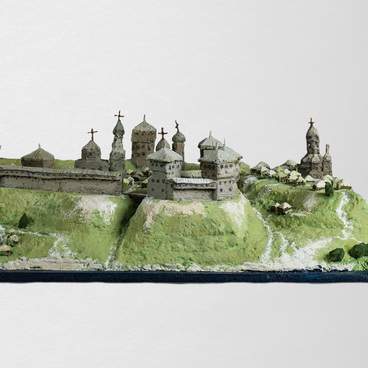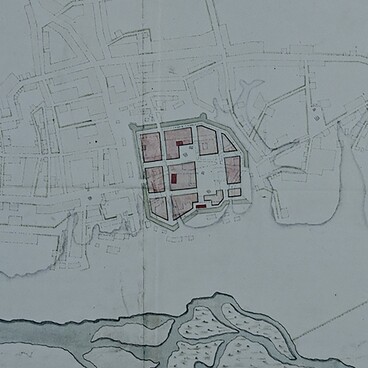Glazed tiles are made as ceramic plates used for stoves, fireplaces and exterior walls tiling. They were different from ordinary tiles by a box-like lug, the so-called “rumpa” on the reverse side. It facilitated fixing stove tiles to masonry. Their front surface can be either smooth or textured, and craftsmen frosted it with clear zinc glaze or opaque tin enamels.
The tiling craft was developed in ancient Egypt and Babylonia. Cone mosaic was the most ancient form of tiling: a clay nail head was glazed and the nail was hammered into the wall. In ancient Mesopotamia, clay walls were faced with glazed bricks with relief patterns for reinforcement.
It is believed that the East Mediterranean was the birthplace of glass making and glazing. Byzantine craftsmen, who worked on the territory of Italy, specifically in Venice houses and temples of Sicily, followed that tradition.
Old Russian craftsmen adopted the Byzantium tiling craft in the post-Mongol period. Initially, they produced gravestones, icons, and terracotta inserts for the brick masonry with inscriptions in bold relief. Sometimes the tiles were frosted with green glaze. Copper and lead ensured the green color of the tile.
During this period, churches and settlements were restored in Rus’. Unfortunately, the Vladimir-Suzdal school’s white stone carving craft of the 12th — 13th centuries had been lost. It was decided to decorate the walls working in a rapid and cheap technique, i.e. with relief bricks made in embossed wooden molds. At first, the tiles were adhered to the brick masonry and whitewashed together with the wall. Later on, red terracotta tiles were used as decorative inserts.
Pogar craftsmen produced two types of tiles: tile glazed with different tints of green, and terracotta tile without coating. There were characters, iconic for Little Russia, Great Russia, and Byelorussia, that could be depicted on the tiles: stylized figures of birds, animals, people, the Star of David, a horseman holding a spear in his hand, and a two-headed eagle.
The stoves with green glazed tiles, called “green stoves” in the vernacular, were popular in Pogar. Cossack officer and general ensign Nikolay Khanenko mentioned such kind of a stove in his memoirs. He wrote that he took a Pogar craftsman to his own estate in the Gorodishche village to make a “green stove” in the hall. The story also mentioned the surname of one of the Pogar craftsmen — Chyorny.
The stove tile, exhibited in the Radogoshch museum, was made at the turn of the 18th century. It is a dark green glazed tile with a rumpa. By the late 18th century, the tile production in Pogar had considerably changed. Smooth-surface painted tiles became available together with the low relief terracotta, green and colored tiles.
The tiling craft was developed in ancient Egypt and Babylonia. Cone mosaic was the most ancient form of tiling: a clay nail head was glazed and the nail was hammered into the wall. In ancient Mesopotamia, clay walls were faced with glazed bricks with relief patterns for reinforcement.
It is believed that the East Mediterranean was the birthplace of glass making and glazing. Byzantine craftsmen, who worked on the territory of Italy, specifically in Venice houses and temples of Sicily, followed that tradition.
Old Russian craftsmen adopted the Byzantium tiling craft in the post-Mongol period. Initially, they produced gravestones, icons, and terracotta inserts for the brick masonry with inscriptions in bold relief. Sometimes the tiles were frosted with green glaze. Copper and lead ensured the green color of the tile.
During this period, churches and settlements were restored in Rus’. Unfortunately, the Vladimir-Suzdal school’s white stone carving craft of the 12th — 13th centuries had been lost. It was decided to decorate the walls working in a rapid and cheap technique, i.e. with relief bricks made in embossed wooden molds. At first, the tiles were adhered to the brick masonry and whitewashed together with the wall. Later on, red terracotta tiles were used as decorative inserts.
Pogar craftsmen produced two types of tiles: tile glazed with different tints of green, and terracotta tile without coating. There were characters, iconic for Little Russia, Great Russia, and Byelorussia, that could be depicted on the tiles: stylized figures of birds, animals, people, the Star of David, a horseman holding a spear in his hand, and a two-headed eagle.
The stoves with green glazed tiles, called “green stoves” in the vernacular, were popular in Pogar. Cossack officer and general ensign Nikolay Khanenko mentioned such kind of a stove in his memoirs. He wrote that he took a Pogar craftsman to his own estate in the Gorodishche village to make a “green stove” in the hall. The story also mentioned the surname of one of the Pogar craftsmen — Chyorny.
The stove tile, exhibited in the Radogoshch museum, was made at the turn of the 18th century. It is a dark green glazed tile with a rumpa. By the late 18th century, the tile production in Pogar had considerably changed. Smooth-surface painted tiles became available together with the low relief terracotta, green and colored tiles.



